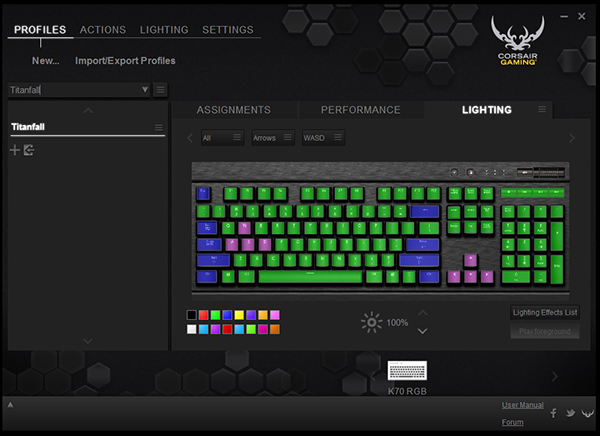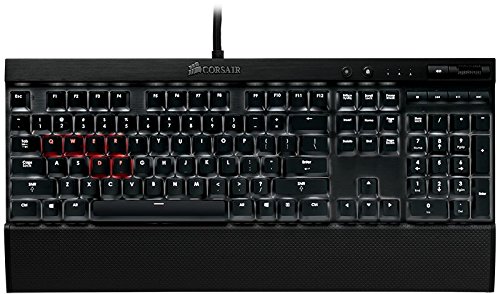Tom's Guide Verdict
The K70 RGB is one of the best gaming keyboards available, offering a plethora of lighting options and solid performance in a sleek design.
Pros
- +
Excellent keys
- +
Gorgeous, colorful backlighting
- +
Sleek, minimalist design
- +
Choice of Cherry switches
Cons
- -
Convoluted software
- -
No textured keys
Why you can trust Tom's Guide
The trouble with innovation is that too often, you have to take two steps forward and one step back. At first blush, the Corsair Gaming K70 RGB ($170) improves in every way over its predecessor, the K70. It's colorful, it feels great and there's a whole new software suite to go along with it.
Dig a little deeper, though, and it seems Corsair sacrificed a lot of the original's simplicity upon the altar of granularity. The K70 RGB isn't quite perfect, but it's still one of the best mechanical keyboards on the market today.
Design
The K70 RGB measures 18.6 x 8.3 inches, making it a bit bigger than its predecessor, the K70, which was 17.2 x 8.3 inches. However, I'm not exactly sure where the extra inch was hiding, as the two devices look almost identical. Either way, the keyboard is a perfectly reasonable size and will fit easily on just about any desk.

Beyond that, the keyboard mirrors its non-RGB counterpart in almost every way. The keys are smooth and black; the wrist rest is large and textured; and there are no extra rows for macro keys. But the K70 RGB's true standout feature is its lighting.
Whereas the standard K70 had only a red backlight (which I described as "garish" in my initial review, and stand by that), the RGB lives up to its name by offering gamers 16.8 million colors to play with. Unlike most keyboards with customizable backlighting, the K70 RGB allows you to customize individual keys, not just choose one color for the entire setup.
MORE: Best Gaming Keyboards
In fact, the sheer variety of illumination options is staggering. Colors — even very similar ones — all look distinct, and the ability to choose a distinct one for each key opens up some truly gorgeous options. For example, I created a profile for Titanfall where most keys were green, the Tab and Backspace columns were blue, and the W, A, S, D and arrow keys were pink. Not only did the contrast make it easy to pick out keys on the fly, but seeing my keyboard change from a default red-and-white into my watermelon monstrosity made me feel like I made something unique out of an everyday product.
Though the lighting is gorgeous, it is much harder to control than it really should be. More on that later.
Keys
If you're familiar with the original K70, then you'll notice that not too much has changed in the K70 RGB. It still has a full keyboard layout without any additional keys for macros. There's a button to adjust the illumination level, one to activate gaming mode (which can disable Alt + Tab and similar combinations that might interrupt your game) and a set of media controls. I particularly like that there's a volume slider rather than two separate buttons.
One thing I do miss about the original, though, is that it came with textured alternatives for the W, A, S, D and arrow keys. Unless you buy third-party keys, the K70 RGB is stuck with the smooth, black keys. They're by no means uncomfortable, but they don't give the extra grip that I found very helpful for first-person shooters, in particular.
The K70 RGB is a mechanical keyboard and comes in three certified Cherry MX flavors: Red, Brown and Blue. For those who need a refresher, Red switches are quiet and pliable, Blues are noisy and resistant, and Browns offer a pleasant middle ground.

In my experience, Cherry-certified switches tend to be better than third-party imitators, and the K70 RGB was no exception. I reviewed the Red model in particular, and although I prefer louder keys, when I pressed each key, it gave a very firm sensation that I was hitting a switch rather than a circuit board. After a long stint reviewing membrane keyboards, it was a real pleasure to use a mechanical one again, and the K70 RGB is one of the most comfortable and tactile ones on the market.
Typists should also take note that the K70 RGB is at least as good as whatever membrane keyboard you're currently using. Using the Ten Thumbs typing test, I scored 91 words per minute with a 0 percent error rate on the K70 RGB, as opposed to 91 words per minute with a 1 percent error rate on a standard Dell office model.
Features
The biggest change from the K70 to the K70 RGB is Corsair's new software, the CUE system. This is also where I ran into the most problems. Corsair's software was always a little impenetrable at the best of times, but the CUE breaks new ground in just how confusing and user-unfriendly a keyboard interface can be.

As previously mentioned, the K70 RGB has some pretty intense lighting options, and CUE allows you to navigate through all of them — although it would be a bit of a stretch to say it "helps" you navigate. Even after an hour-long private conference with Corsair, it still took me a good 15 minutes and a trip to an Internet forum to figure out how to set up a new lighting profile from scratch and assign it as my default.

The problem with the CUE software is that there's no easy mode for users who just want to add a few pretty lights and be done with it. Corsair assumes that every user will be willing to expend the time, effort and programming know-how necessary to generate rippling rainbows or keys that cycle through colors each time they're pressed.
These are all things you can do with CUE, and they look just as impressive as they sound. But aside from exciting the senses, it doesn't really do much for gameplay. Creating custom lighting profiles for Titanfall and Watch Dogs was helpful, but I wish the process had been a little more straightforward. I am (and I imagine many other gamers are) more interested in jumping into a game for an hour or two rather than spending the same amount of time grappling with how cool the keyboard can look.
Otherwise, recording macros, reassigning keys, linking programs and other things you may need are fairly straightforward, once you find out where the options are hiding and how to match them with your custom profiles. There is the nut of a good program in the CUE, but it's hidden underneath a layer of confusion.
Performance
Once you're set up and ready to play, the K70 RGB handles like a dream. I put the peripheral through its paces with Titanfall, StarCraft II: Heart of the Swarm, Watch Dogs and Star Wars: The Old Republic, and it excelled with every game. The keys were comfortable and stood up just fine to vigorous and repeated use.

The keyboard didn't have one particular standout genre, but I especially enjoyed using it to pilot giant mechas in Titanfall and blast my way through Terran armies in Heart of the Swarm. A full-size keyboard that has a numpad but lacks macro buttons is ideally suited for first-person shooters and real-time strategy games, but it will work just fine for moderate massively multiplayer online (MMO) play. (A controller is still better for action/adventure titles like Watch Dogs.)
MORE: Best Gaming Mice
My only real criticism here is that the keyboard lacks on-the-fly macro recording, so you'll have to memorize your timing pretty well (or use a second monitor) if you want to record and assign macros with the CUE software. Even then, since there are no dedicated macro buttons, you'll have to replace something else. This didn't compromise my experience with any of the games I tested, including The Old Republic, but hardcore MMO players will need a different keyboard.
Bottom line
The K70 RGB presents something of a recommendation dilemma. Technically speaking, it's a better, more refined product than its predecessor, but its software is also more difficult to use. If I had to buy any new keyboard today, it would probably be the K70 RGB — yet if I could find a regular K70 for a fraction of the price, I could probably live with the ugly red lighting and happily pocket the savings.
Pick up the K70 RGB if you want one of the best keyboards available right now, but don't be surprised if you have to spend some time grappling with it before you understand why it earns the title.
Specs
Actuation: 65 g
Key Travel: 4 mm
In-Key Rollover: >10
Size: 17.1 x 8.3 x 1.4 inches
Weight: 2.64 pounds
Marshall Honorof is a senior editor for Tom's Guide, overseeing the site's coverage of gaming hardware and software. He comes from a science writing background, having studied paleomammalogy, biological anthropology, and the history of science and technology. After hours, you can find him practicing taekwondo or doing deep dives on classic sci-fi.
-
Baconhashtags Nice keyboard i think its probably a bit expensive something you would keep on your next build or definetly replace, great idea for a special gift for some one for programming in the dark!Reply -
chrisafp07 Nice review, I have noticed that there are many reported issues with the LED's going dead. I own a k70 and switched to a g710+ for that very reason, all my LED's started to die. Not one has died on my g710.Reply -
Baconhashtags Reply14295814 said:Nice review, I have noticed that there are many reported issues with the LED's going dead. I own a k70 and switched to a g710+ for that very reason, all my LED's started to die. Not one has died on my g710.
#Well with what I'm going to say next Corsair will probably send someone to shoot me, but they state a 2 year warranty with the Keyboard! So you should get a replacement free in the event of failure, however maybe some people can replace the LEDs themselves or perhaps research extended warranty options and if corsair offers servicing! Also preserve the life span of the keyboard by only using it for those late night, clan mandated sessions.
I am sure that most LEDs boast a an apx life span between 25,000 - 100,000 hours which is about 10years, however performance may vary depending on some factors such as build quality and treatment!! -
GreyPhantom Reply14287152 said:The K70 RGB is one of the best gaming keyboards available, offering a plethora of lighting options and solid performance in a sleek design.
Corsair Vengeance K70 RGB Review — Rainbow in the Dark : Read more
I'm here because i heard there were prizes. Now i'm drooling over this keyboard. -
ubercake The ability to customize to your desired color scheme is a good feature. Cherry switches are always a plus.Reply -
LeCreaux I have a first-generation K70. It's an awesome keyboard, but the lights didn't last 6 months. They all started failing within minutes/hours of each other so I doubt it's the LEDs...it's either the circuitry or the design. The keyboard still functions perfectly with no lights...but the lights were the selling point. I'm just not going to gamble on another Corsair.Reply -
ander Yes, a K70 may be, say, $20 more than other keyboards you're looking at—but put it in a bit of perspective. These are Cherry switches. They'll probably last longer than you will. $20 stretched out over several years, at least, is virtually nothing. Go for the quality, which you can enjoy every day—that's what I did!Reply


